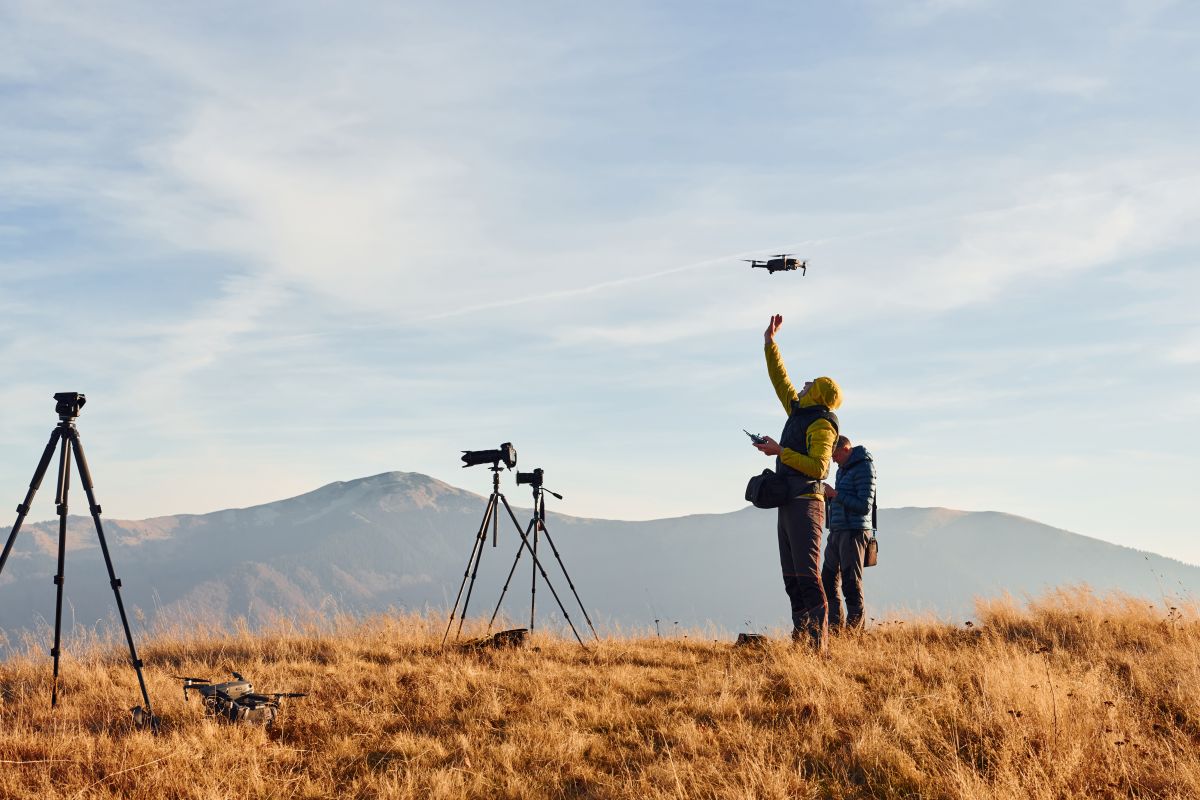
A Video Productions Company’s Insights into Drone Cinematography in Documentary Videos
Documentaries have long relied on visual perspectives to inform, contextualise, and immerse viewers in real-world narratives. Among the tools available to professional production teams, drones have introduced a new dimension, allowing for sweeping aerial perspectives that extend the narrative beyond what can be captured from the ground. A video productions company can employ drones to reveal the interaction between people and their environment, illustrate changes over time, and provide context for stories that might otherwise be confined to individual experiences. Let’s explore how drone cinematography can enhance documentaries, demonstrating both its narrative potential and its ability to communicate information in a visually precise and meaningful way.
Establishing a Sense of Place for the Audience
In documentary videos, establishing a sense of place is essential. The setting is often as influential to the story as the people within it, shaping actions, decisions, and experiences. Drone cinematography enables a single shot to communicate complex environmental information, including geography, settlement patterns, and spatial relationships.
For instance, an aerial view of a community bordering a river can contextualise both its isolation and its connection to the surrounding ecosystem. This method allows viewers to orient themselves within the story, understanding the broader environment before the narrative focuses on individual subjects. A video productions company can use these aerial sequences to create a natural visual introduction to a location, providing context and clarity without diverting attention from the story itself.
Documenting Change Over Time with Drones
One of the most significant contributions of drone cinematography to documentaries is the ability to track change over time. Returning to the same location months or years apart allows production teams to document transformations that may not be apparent from ground-level footage. This can include environmental shifts, such as coastal erosion or deforestation, as well as human developments like urban expansion or agricultural change. The repeatable nature of drone flights ensures consistency in perspective, altitude, and framing, allowing for direct visual comparison across time. For documentaries concerned with investigative or environmental topics, these sequences provide evidence of change that supports both the narrative and factual integrity. Incorporating drone-captured sequences allows a video productions company to visually reinforce the passage of time and highlight developments that are integral to the story.
Character and Environment Relationship
Aerial footage can reveal the relationship between individuals and the spaces they inhabit. In human-centred documentaries, showing a subject within the scale of their environment conveys vulnerability, resilience, or isolation. For example, observing a lone farmer in an expansive arid field communicates both the magnitude of their challenge and their agency within it. Similarly, a fisherman navigating open waters can appear both small and connected to the ecosystem that sustains their livelihood. These visuals offer viewers a richer understanding of context, enabling them to interpret personal narratives within larger societal or environmental frameworks. Professional drone usage allows a video productions company to integrate these perspectives seamlessly into a documentary, emphasising relationships without relying on narration alone.
Intimacy versus Distance: Balancing Aerials with Ground Perspective
Aerial views provide context and scale, but intimate ground-level shots reveal emotion and detail that aerial imagery alone cannot. Effective documentary storytelling balances these perspectives:
- Use aerials for context: Introduce locations, spatial relationships, or group dynamics.
- Use ground shots for intimacy: Interviews, observational details, or personal interactions.
- Sequence thoughtfully: Alternate perspectives at appropriate pacing to maintain narrative cohesion and viewer focus.
Maintaining this balance allows the audience to understand both the broader environment and the human experiences within it. A video productions company can manage perspective transitions to ensure the story remains visually informative while emotionally accessible.
Drones as Means of Access and Discovery
Drones enable filmmakers to reach and observe locations that are otherwise difficult or unsafe to access. They open possibilities for documenting situations that might not be achievable with conventional methods:
- Remote regions that are difficult to traverse on foot.
- Disaster zones where safety concerns prevent a ground crew.
- Wildlife habitats that require minimal disturbance to observe natural behaviour.
- Investigative observation in areas that are sensitive, restricted, or challenging to approach.
By extending observational reach, drones allow a video productions company to gather visual information that supports investigative, environmental, or human-focused narratives. These sequences provide audiences with insights that complement ground-level filming, without compromising safety or authenticity.
Aesthetic Choices: Movement, Framing, and Visual Tone
The way an aerial shot moves and is framed can communicate information, mood, and pace within a documentary. Different movements serve distinct purposes and convey different types of visual information. Key approaches include:
- Slow rising reveals to encourage reflection or highlight scale.
- Lateral tracking to indicate movement, progress, or journey.
- Top-down geometry to demonstrate patterns of human activity, infrastructure, or environmental features.
- Orbiting a subject to show interaction with surroundings and emphasise spatial context.
These choices influence how viewers perceive information and narrative emphasis. By selecting movements intentionally, a video productions company can reinforce understanding of the environment and relationships without distracting from the documentary’s subjects.
Emotional Geography: Drone Footage as a Transition Device
Aerial footage can function as an intermediary between scenes, allowing viewers to shift their attention across time, space, or emotional tone. Pulling back to a bird’s-eye perspective after an interview, for example, provides room for reflection and situates individual experiences within a wider context. Similarly, a drone flyover can signal a transition to a new location or narrative segment, helping viewers to orient themselves visually and cognitively. When used in this way, aerial sequences contribute to the narrative flow rather than serving as ornamental additions. A video productions company can use these sequences strategically to maintain coherence and pacing while preserving the documentary’s observational integrity.
Observational Neutrality versus Directorial Intent
Drone cinematography requires careful consideration of narrative influence. Aerial vantage points may unintentionally shape the viewer’s interpretation, presenting a perspective that could feel intrusive or interpretive. Slow, steady ascents often encourage reflection, whereas rapid or sweeping movements may impart urgency or drama. Production teams must decide whether to maintain observational neutrality or to guide the audience’s interpretation through visual composition. In documentaries, this choice directly impacts how subjects and events are perceived. A video productions company can navigate this balance to ensure that the aerial footage supports the intended tone and maintains alignment with the documentary’s narrative approach.
Enhancing Verité Storytelling Without Disruption
Maintaining authenticity in documentary filmmaking is essential, and drones must operate without interfering with natural behaviour. Noise, proximity, and visual presence can alter the environment and the behaviour of subjects. Silent operation, strategic altitudes, and minimal on-site crew presence help ensure that aerial footage does not compromise observational integrity. In addition, preplanned flight paths and careful coordination with the production team prevent unintentional disruption. Employing drones responsibly allows a video productions company to expand observational capacity while respecting the conditions that make verité storytelling effective.
Authenticity versus Cinematic Composition
Documentaries face a decision regarding the visual presentation of aerial footage. Raw, observational shots may convey immediacy and realism, whereas composed, stable footage emphasises framing, pacing, and narrative flow. Each approach communicates different information and emotional weight to the audience. Choosing the appropriate style requires alignment with the documentary’s intent, ensuring that aerial sequences enhance comprehension without altering perception. This consideration informs the selection of drone operation techniques, camera angles, and shot duration, all of which contribute to a coherent visual narrative.
Collaborating with Operators Who Understand Documentary Principles
The expertise of drone operators directly influences the quality and integrity of footage. Professional operators for documentaries prioritise discretion, patience, and awareness of narrative and ethical considerations. They adapt to the unpredictable nature of real-world filming, ensuring minimal disturbance to subjects while maintaining visual and technical standards. With skilled aerial operation as part of the team, a video productions company can integrate sequences seamlessly, reinforcing both observational fidelity and narrative clarity.
Visual Insight and Perspective
Drone cinematography provides a dimension of visual insight that is uniquely suited to documentary storytelling. By bridging the gap between environment, character, and time, aerial footage extends the narrative scope without overshadowing it. When applied with purpose and consideration, drones enhance both understanding and engagement, offering perspectives that would otherwise remain unseen. In this context, a professional video productions company demonstrates the value of integrating aerial sequences as part of a thoughtful, observational approach to documentary video production.
Documentary filmmaking is about presenting reality in ways that are both informative and meaningful. Thoughtful application of drone cinematography adds perspective, context, and visual clarity, supporting the narrative without imposing upon it. For organisations seeking professional documentary production that combines careful observation with expansive visual scope, Sound Idea Digital can provide a full range of services. Get in touch with us today to discuss how your project can benefit from these approaches.
We are a full-service Web Development and Content Production Agency in Gauteng specialising in Video Production, Animation, eLearning Content Development, Learning Management Systems, and Content Production.
Contact us for a quote. | enquiries@soundidea.co.za | https://www.soundideavideoproduction.co.za| +27 82 491 5824 |

